Part 6⁄7 During medieval times, Muslim scholars tried to determine why early mosques did not face Mecca in Saudi Arabia. Some modern scholars seem to embrace their explanations. Gibson also examines the direction of the Ka’ba and the names of the corners of the Ka’ba building.
Transcript
Hello, I am Dan Gibson, and this is another video in the series The Qibla Story.
So far we have traced the development of the Qibla, from the beginning of Islam, through the city of Petra, then Mecca, then the Between Qiblas, the parallel Qiblas, and in the last video we looked at the crumbling of the Umayyad caliphate, and the shame that was attached to this period of time.
The Abbasids brought about a new day for Islam. First, Abu ‘Abbas a-Saffah’ arranged the killing of all of the remaining Umayyads. In the end, only one escaped. Abd ar-Rahman ibn Mu’awiya, escaped to Spain, where the Umayyads would continue to rule for another 300 years. Back in the Middle East, Abu ‘Abbas a-Saffah made the city of Kufa his new capital city, and went about putting down rebellions and solidifying the military might of the Abbasid army. A couple of years later he died of small-pox.
The next caliph was Al-Mansur, who was also of Muhammad’s family, and like Abu Al-Abbas was also from the small town of Humaima, near Petra.
In the year 145 AH (762 AD) Al Mansur built a new capital city, known as Madinat is-Salam or The City of Peace. That city became the core of what is known today as Baghdad.
Now Al-Mansur had a problem. His brother, Abu a-‘Abbas had tried solidifying the Islamic Empire through military might, and he had some success. So al-Mansur continued to use force but he needed something more. So Al-Mansur came up with additional solutions. These solutions focused on ‘image’. Up until this time, Islam appeared to many outsiders as a bloody religion. There was a lot of killing, beheading, and forcing people to pay a special tax on non-Muslims or die. Al-Mansur needed to change the image of Islam. And so he began with his new “City of Peace.”
This was a city that focused on the arts, on science, and on education, as well as on housing the growing number of bureaucrats that the Empire needed to rule from North Africa to central Asia. Perhaps the arts, the science and the education were only started to serve the bureaucrats, I don’t know. Whatever the reason, the government invested in the founding of institutions and sponsoring individuals that would serve the purpose of providing a new image for Islam.
One of the first things al-Mansur did was to establish a library. His main problem was that books and scrolls were available in other languages, but not so much in Arabic, the language of the Muslim court. So Al-Mansur brought groups of Syriac-speaking Christians to Baghdad to translate books from Syriac and Greek into Arabic. He also incorporated a Persian library and ordered the translation of many science and philosophy books written in Persian into Arabic. The availability of these new resources began to attract scholars hopeful for court sponsorship (meaning money to live by) and eventually various new schools developed around these scholars.
Al-Mansur was the 2nd Abbasid Caliph. Eleven years after he died, caliph Harun ar-Rashid, founded the famous House of Wisdom as a library for the collections of translated books and works. Over the years, many famous academics were attracted to the city. Note, 500 years later, in 1258, the Mongols invaded Baghdad. They burned the House of Wisdom and threw the ashes and what was left into the Tigris River, bringing an end to the Islamic Golden Age.
What is of interest to us in this series of videos; is how this affected the Qibla of Islam.
Remember, under the Umayyads there were at least 5 different Qiblas. When the City of Peace was constructed, a mosque was placed in the very centre, with its Qibla wall fashioned so that the faithful faced Mecca in Saudi Arabia. Then a circular city was constructed around this great mosque. There was no question of the Qibla direction. All mosques built by the Abbasids faced Mecca in Saudi Arabia.
But there was a question: Was there a better way to determine the Qibla direction?
The gathering of scholars in one city, with a focus on a central library, and a number of new schools, brought about a revolution in academia. Up until this time, scholars would study and write papers in their far flung corners of the earth, and it took many years for their writings to circulate, and eventually be translated into other languages.
Sometimes we fail to appreciate the time this would take. Often a scholar was long dead before his ideas were known to other scholars. This persisted until the 1700s when the first peer reviewed journals began to appear. So the exchange of research information was long, slow and tedious. But the House of Wisdom and the atmosphere in Baghdad changed all that. Suddenly great scholars were in the same city. They had access to the same great libraries, and could even interact with one another.
This created academic synergy, and a burst of academic advancement only occasionally seen in human history. In Baghdad this time of academic advancement, blossomed over several hundred years. But right from its inception, state sponsorship and government control was evident. The new Islamic state in Baghdad was concerned that the religion of Islam, and their rule was always reflected in a good light.
So while new innovations in science, mathematics, and astronomy were greatly encouraged, innovation was not encouraged in history or religion. During this time, a number of noted historians were sponsored by political figures or the government in general.
Now this is not a new thing. Even the great Roman historian, Strabo, was sponsored by high ranking Roman officials. He even stayed for extended periods in the home of a Roman general, while compiling his “glorious history of Rome”. Was he influenced by his sponsor? You can be sure.
In the case of the Muslim chroniclers of history, one thing was certain: their histories would never reflect negatively on the religion of Islam or the character of the prophet Muhammad, or the right of the Abbasids to rule. So while they could speak derogatorily about the evils of the previous Umayyad rulers, they could not reflect badly on Islam as a religion. This bias is reflected in all of the histories written under the Abbasids. And they ruled for many centuries.
Another interesting observation we can make, is that there was a particular interest at this time, among mathematicians, in discovering better ways to calculate the Qibla direction.
I have gone through a list of the famous academics of this time period, and have made a shorter list of those who were particularly interested in math, astronomy, and Qibla studies. Each scholar added another piece to the puzzle. Here is the list, from earliest to later. The dates are listed when the scholar died, or was at the height of his writing, which was usually later in life.
Now, one of the world experts on this time period was Dr. David A King, who has written a host of papers on this time period and on the work of a number of these medieval scholars who were instrumental in Qibla studies.
Dr. King has disagreed with me on my conclusions about the 5 different Qibla directions in early y Islam. So I feel I must address his proposal when talking about the Medieval Mathematicians. Dr. King has disagreed with me on my conclusion of 5 different Qibla directions in early Islam. So I feel I must address his proposals when talking about the medieval mathematicians.
One of the earlier publication of Dr. King’s about the Qibla was done as a joint paper with the famous astronomer Dr. Gerald Hawkins, who made a startling conclusion in his 1965 book on Stonehenge. But he was not the first. He used the ideas put forward by Dr. Alexander Thom in his series of papers published on Stonehenge.
Dr. Thom, and later Gerald Hawkins claimed that Stonehenge was an astronomical observatory to predict the movement of the sun and stars. At the time this was very poorly received in the academic world, but his book quickly became popular among conspiracy theorists, and new age folk. That was the beginning of the popularizing of the new science of archeo-astronomy.
Then, almost twenty years later, Dr. King produced an academic paper on the Qibla, with this same Dr. Gerald Hawkins of Stonehenge fame.
Dr. King’s theory was based on the orientation of the Ka’ba building itself. Just as in Stonehenge, these men measured the Ka’ba building, and looked for any corresponding relationship to the stars.
In a 1982 paper jointly written by King and Hawkins, they produced this chart based on what correlations they could find between the Ka’ba building and the stars in the sky.

King & Hawkins illustration
In the same paper they also produced another chart. Notice that no specific degrees are given. It is all in generalities, as they concluded that the Arabs of that time could only determine direction in generalities. From this chart one might think that the Ka’ba building had amazing alignments.
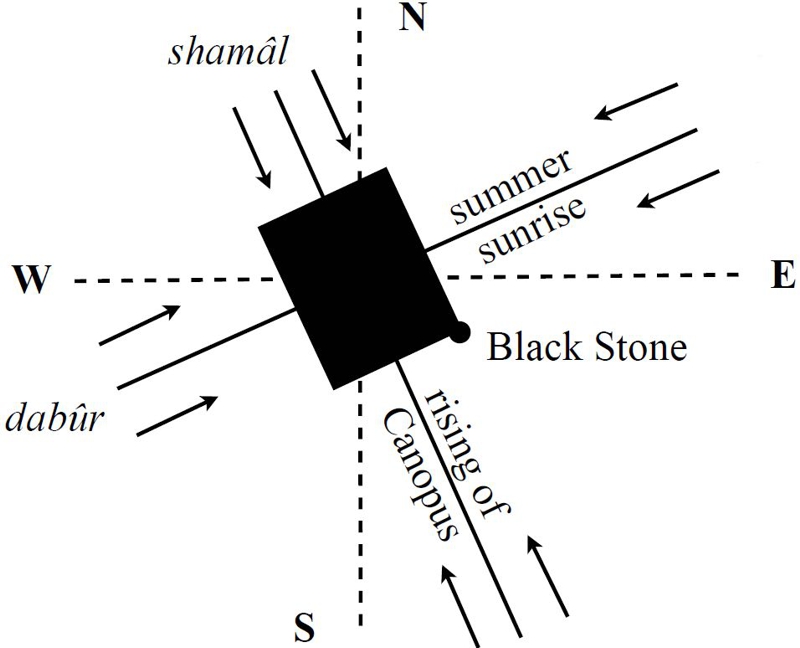
King & Hawkins illustration
In the end, some years later, Dr. King settled on this chart to explain the Ka’ba orientation. And now we are a little closer to the truth.
Now don’t be fooled by the Arabic words. shamal simply means north. And dabur can mean west. Although it is not anywhere near west, but I guess it means it is closer to west than it is to south.
So how sure was Dr. Gerald Hawkins about the accuracy of this whole thing? He is one of the authors of this paper. Here is how Dr. Hawkins ends the paper.
From the point of view on an astronomer, the medieval text references are not exact or specific, though there are general references to the rising of the sun, moon and stars. … there are inconsistencies where-in the medieval writer has apparently inverted rising and setting, and there are ambiguities, such as what does “opposite the western corner” mean?
Nor are the astronomical dates clearly established… the one text cited was written about 1290 AD but the original Ka’ba was constructed over a thousand years earlier.
Notice what Dr. Hawkins is saying. Many of the medieval writers are hundreds of years late. Here are some of the sources that Dr. King uses. I gleaned these from his later papers.
After his comments about how tenantable the data is, Dr. Hawkins sates:
… however, for the information of historical scholars, measurements have been obtained and astronomical calculations made.
What does he mean by this? I will let you guess, but it sounds like we mere historical scholars should be satisfied with general calculations. Then Dr. Hawkins discusses their sources:
The altitude of the skyline surrounding the Ka’ba was obtained from the map published by the Municipality of Mecca in 1967, and the walls and the diagonals of the Ka’ba were also read off the map. I am sorry we don’t have a copy of that map and I haven’t been able to find a copy, so I cannot tell you if it was intended for scientific use, or if it was merely a tourist map. Dr. Hawkins goes on:
… The alignments to the Sun as referred to in the texts are accurate to no better than 5 or 10 degrees. What? They couldn’t get a reading on the sun, better than 5 or 10 degrees! I doubt the map was very accurate! But let’s listen to Dr. Hawkins.
- … The alignment to the stars of the Plough seems to be more relevant to the medieval period than to the time of the laying of the foundations of the Ka’ba.*
So that measurement, which was published here, is no longer mentioned by Dr. King in his later papers. But five years later, Dr. King was publishing papers, with only his own name on them, and the cautionary tone set by Dr. Hawkins was no longer there. Instead, Dr. King now wrote with assuredness. For instance, in his 1987 article in the Encyclopedia of Islam, Mecca as the centre of the World, it contained none of the original cautionary comments of Dr. Hawkins.
Eventually Dr. King seemed to be taking the medieval writers seriously, believing that they were telling us how things actually donee, centuries before. His articles had no hint that Al-Biruni and others were merely suggesting possible solutions. Suddenly they were telling us accurately and with assurance how the Qibla was established before the science of mathematics provided methods of being much more accurate. That is why they had these Qiblas facing in different directions.
It is here that I have trouble with Dr. King. It is the tone of his research and not the actual research itself.
As I see it, Al-Biruni and others were merely trying to explain how the earlier Qiblas were set. They were doing their best, but they did not have the information we have today. They had access to only a few old mosques in the towns where they lived or had visited.
We are going to end in just a few moments, but I want us to think carefully about what we can learn about the Ka’ba in Mecca.
You see, the scientific data that we have collected, and is freely available on the internet in the form of the Qibla Tool, (https://nabataea.net) demonstrates to us, that the first Qibla pointed to Petra in Jordan.
- Over 30 mosques faced Petra. The other mosques that remain from that period of time have all be destroyed and rebuilt, so we can no longer examine their original foundations and determine their original Qiblas. So we have not found a single mosque that points to any other place than to Petra from that time period.
- When we go to Petra, we can find the foundations of the original Ka’ba. This edifice fits the measurements given to us by Azraqi. He writes of the Ka’ba that stood during Muhammad’s life time.
- The Ka’ba stands in the corner of the courtyard, just like the early accounts describe it.
- The wall around the courtyard contains the Hatim, or bulge in the wall which seems to have gone around the grave of Ishmael.
- Later, that wall was joined to the Ka’ba building. That we can see in Mecca.
- Later the Ka’ba was centered in a large court area. We can see that in the Ka’ba in Mecca. And we can trace which caliphs made these changes. So what about the Ka’ba in Mecca? What can we learn from its shape and direction?
- First, it is a different size from the original Ka’ba as told to us by Azraqi. I do not think that the shape of the walls or angles of the building demonstrate anything.
- But there is one thing we can tell. When the Hatim wall was attached to the Ka’ba building it gave the Ka’ba in Mecca a direction. The Hatim provides a face for the Ka’ba. And where does it face? Just follow the direction north, until it reaches the first Ka’ba in Petra. That is what the Ka’ba in Mecca is trying to tell us. It is not about stars and angles and the sun and moon. This is not Stonehenge. The Ka’ba building itself, in Mecca faces the original Ka’ba building in Petra.
Now there is a second issue I want to address, and we will close with this. From ancient times the corners of the Ka’ba building have had names.
Here are the names: The Iraqi corner, The Yamani corner, the Shami corner, and the Black Stone corner.
Let’s place a large drawing of the Mecca Ka’ba onto a map. How much sense do the corners make?
What if you tried to rearrange the names? If you put Shami at the north, then Iraq would have to point east.
The names of the Ka’ba corners do not make sense in Mecca in Saudi Arabia? You can’t even re-arrange them to make sense.
What about in Mecca in Jordan, known today as the city of Petra. What about in Petra? Look here, the names actually point in the correct direction, and make sense.
Friends, without understanding the importance of the First City of Islam as Petra, the alignment of the Ka’ba building, and the names of the four corners are hard to explain. Once we study the original Ka’ba building, it is much easier to understand the Ka’ba building in Mecca, in Saudi Arabia.
I am Dan Gibson, and this has been another video in the series The Qibla Story.
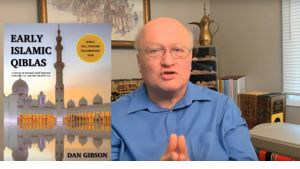
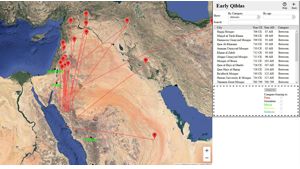
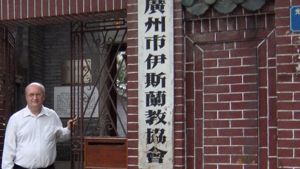
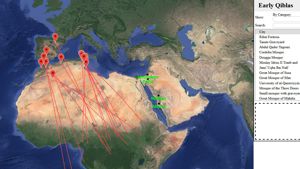

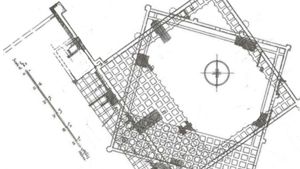
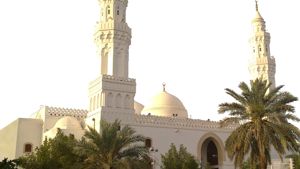
Page Discussion
Membership is required to comment. Membership is free of charge and available to everyone over the age of 16. Just click SignUp, or make a comment below. You will need a user name and a password. The system will automatically send a code to your email address. It should arrive in a few minutes. Enter the code, and you are finished.
Members who post adverts or use inappropriate language or make disrespectful comments will have their membership removed and be barred from the site. By becoming a member you agree to our Terms of Use and our Privacy, Cookies & Ad Policies. Remember that we will never, under any circumstances, sell or give your email address or private information to anyone unless required by law. Please keep your comments on topic. Thanks!